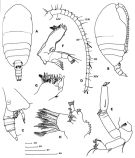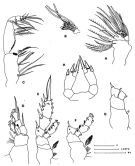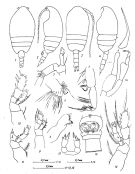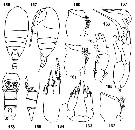|
|
 |
Fiche d'espèce de Copépode |
|
|
Calanoida ( Ordre ) |
|
|
|
Clausocalanoidea ( Superfamille ) |
|
|
|
Tharybidae ( Famille ) |
|
|
|
Tharybis ( Genre ) |
|
|
| |
Tharybis groenlandicus (Tupitzky, 1982) (F,M) | |
| | | | | | | Syn.: | Xanthocalanus groenlandicus Tupitzky, 1982 (p.297, figs.F,M);
Tharybis crenata : Schulz, 1995, in Schulz & Beckmann, 1995 (p.207, figs.F); Bradford-Grieve, 2004 (p.285) | | | | Ref.: | | | Campaner, 1983 (comm. pers.); Schulz & Beckmann, 1995 (Rem.: p.210); Andronov, 2002 (p.37, figs.F,M); Ferrari & Markhaseva, 2005 (p.46: tab.1); Blanco-Bercial & al., 2011 (p.103, Table 1, Biol. mol, phylogeny); Laakmann & al., 2019 (p.330, fig. 2, 3, phylogenetic relationships) |  issued from : Schulz & Beckmann, 1995, 80. [p.208, Fig.5]. As Tharybis crenata. Female (from Iceland Basin): A, habitus (dorsal); B, idem (lateral right side); C, urosome (lateral right side); D, A1; E, A2; F, Md; G, Md (cutting edge); H, Mx1; Scale bars = 0.100 mm. Nota: Cephalosome and pediger 1 weakly separated dorsally, more or less ventrolaterally, 4th and 5th pedigers fused. - Posterior corner of prosome lobate and rounded, covering half of genital double-somite laterally. - Urosome short, ratio of prosome to urosome length 3.7 : 1. - In dorsal view genital double-somite with shallow lateral indentation on both left and right side. - Anal somite a very short and narrow ring, especially dorsally, and almost completely telescoped into preceding somite. - Caudal rami slightly longer than wide, bearing 1 ventral seta and 4 terminal setae. - A1 24-segmented, reaching slightly beyond 2nd pedigerous somite. - A2 segmentation and armature similar to those of T. angularis except for: the larger of the two basal setae only about half length of 1st endopod segment, and exopod being slightly less than twice length of endopod.. -Md coxa with strong gnathobase bearing molariform teeth complex ventrally and a number of setiform teeth dorsally covered by numerous spinules both anteriorly and posteriorly; basis armed with 2 curved spiniform setae and 1 long straigth subdistally implanted seta; endopod slightly longer than exopod, bearing 9 terminal setae; exopod 5-segmented, carrying 6 setae. - Mx1 armature like that of T. angularis except distal basal endite with 2 setae..
|
 issued from : Schulz & Beckmann, 1995, 80. [p.209, Fig.6]. As Tharybis crenata. Female: A, Mx2; B, Mx2 (endopod); C, Mxp; D, P1; E, P2; F, P3; G, P4; H, P5. Nota: Mx2 with endopod carrying 6 brush-like filaments proximally and 3 longer worm-like filaments distally. Praecoxa with distinct outer hump, praecoxal and coxal endites bearing 4, 3, 3, and 3 setae; endite of basis with 4 setae. - Mxppraecoxal and coxal endites equipped with 1, 2, 3, and 3 setae from proximal to distal, the medial endite bears 1 aesthetasc-like spinulose seta terminating in a brush-like tip; endopod 6-segmented bearing 2, 4, 4, 3, 3+1, and 4 setae. - P5 uniramous, 3-segmented and extending to distal margin of 2nd urosomal somite; coxae fused to form common base; endopod lacking; exopod less than twice length of basis, terminating in 2 pointed processes and 1 robust inner edge spine, all bearing marginal denticles. Ratio of lengths of outer and median processes and inner spine roughly 1 : 2 : 3.
|
 issued from : V.V. Tupitzky in Zool. Zh., 1982, 61 (2). [p.298]. As Xanthocalanus groenlandicus. Female (from northern Greenland Sea): 1, habitus (dorsal); 2, idem (lateral left side); 5, A2; 6, Mx2; 8, Md (mandibular blade); 9, P1; 11, P2; 13, P5; 15, genital segment (ventral). Nota: A1 23-segmented. Male: 3, habitus (dorsal); 4, idem (lateral left side); 7, Mxp; 10, P2; 12,P3; 14, P5
|
 issued from : V.N. Andronov in Arthropoda Selecta, 2002, 11 (1). [p.
39, Figs.156-168]. Female (from Greenland Sea): 156-157, habitus (dorsal and lateral, respectively); 158-159, urosome (ventral and left lateral side, respectively); 160-162, basipod segment 1 of P2 to P4; 163, P5; 164, distal segment of P5. Male: 165, P5; 166, endopod of left P5; 167, distal segment of exopod of left P5. 168, endopod of P2.
| | | | | Ref. compl.: | | | Kosobokova & al., 1998 (tab.2); Kosobokova & Hirche, 2000 (p.2029, tab.2); Auel & Hagen, 2002 (p.1013, tab.2); Kosobokova & al., 2007 (p.919, Tab.2, 6, fig.2, as groenlandica); Kosobokova & Hopcroft, 2010 (p.96, Table 1, fig.7); Kosobokova & al., 2011 (p.29, Table 2, fig.4, Rem.: Arctic Basins) | | | | NZ: | 2 | | |
|
Carte de distribution de Tharybis groenlandicus par zones géographiques
|
| | | | Loc: | | | Arct. (Lomonosov Ridge, Laptev Sea, Nansen Basin, Amundsen Basin, Makarov Basin, Canada Basin), S Iceland | | | | N: | 7 | | | | Lg.: | | | (453) F: 1,5-1,4; M: 1,4; (1001) F: 1,2; {F: 1,20-1,50; M: 1,40} | | | | Rem.: | meso-bathypélagique | | | Dernière mise à jour : 02/04/2019 | |
|
|
 Toute utilisation de ce site pour une publication sera mentionnée avec la référence suivante : Toute utilisation de ce site pour une publication sera mentionnée avec la référence suivante :
Razouls C., Desreumaux N., Kouwenberg J. et de Bovée F., 2005-2026. - Biodiversité des Copépodes planctoniques marins (morphologie, répartition géographique et données biologiques). Sorbonne Université, CNRS. Disponible sur http://copepodes.obs-banyuls.fr [Accédé le 07 janvier 2026] © copyright 2005-2026 Sorbonne Université, CNRS
|
|
 |
 |







